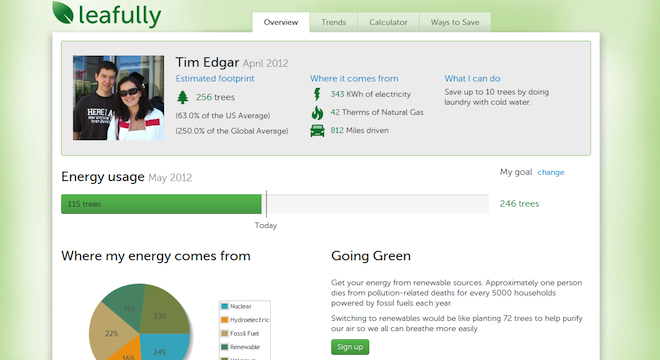Updated 4:16 pm ET, Tuesday, May 22
It would take roughly ten to fifteen trees to offset the amount of carbon produced by leaving your computer on every night for a month. Does knowing that motivate you to turn off your computer tonight?
It should. At least, that’s the idea behind Leafully, an app that was on Tuesday awarded $30,000 and the grand prize in a public competition held by the U.S. Department of Energy for developers to create software that allows homeowners and businesses to better track and conserve on their energy usage.
Leafully works by allowing users to log in on its website with their Facebook accounts and compare how much energy they’re using and saving against their friends.
Watch a video demo of the app in action here:
The app was created in a marathon, two week sprint of coding by Timothy Edgar and Nathan Jhaveri, both software engineers and colleagues at Microsoft HQ in Seattle, Washington, where they specifically work on the Bing search engine.
But Edgar and Jhaveri were quick to point out that Leafully was developed separately from their work at Microsoft, during their off-time.
“It’s totally a side project,” Jhaveri told TPM in a phone interview, “We did it in our off-hours. Microsoft allows employees to work on their own interesting projects, so long as they don’t conflict with Microsoft products.”
Jhaveri said that Microsoft was unlikely to be interested in picking up the app to further its own carbon neutral ambitions, and that he and Edgar were planning on using the prize money to continue to develop Leafully as a separate startup company.
Edgar said the duo came up with the app in late April, after his girlfriend told him about the Energy Department’s “Apps for Energy” competition. As such, they had to race to meet the program’s May 15 deadline.
“It would have been nice to have more time,” Edgar conceded to TPM, but added “I’m surprised at how well it turned out.”
Edgar said in total, they spent about 150 hours developing the prototype that they submitted to the Energy Department and posted online for the public to use and provide feedback.
Leafully aims to automatically retrieve a user’s monthly energy consumption data from their utility and presents it in terms of how many trees it would take to offset their overall carbon footprint — the amount of carbon dioxide and other greenhouse gases emitted by the user’s energy sources.
Leafully also creates an elegant profile page for the individual user, based on their Facebook profile, showing such information as how the user’s energy consumption compares to the national average (958 kilowatthours (kWh) per month as of December 2011, according to the government), as well as the actual fuel sources of the user’s utility energy, along with estimates of gas and car fuel carbon emissions, which the user can adjust with their own data to provide increased accuracy. Leafully obtained its comparative data for the project from various public governmental resources online.
The app also has an adjustable “slider bar,” similar to some online banking apps, which gives users the opportunity to set monthly energy savings goals for themselves in terms of numbers of trees planted equivalent to the reduced energy usage. There are even more granular tabs showing constant energy usage, peak usage and other trends.
So far, the app only provides automatic data analysis for customers of Pacific Gas and Electric (PG&E), a Northern California utility that counts 15 million people among its customers, but Leafully allows customers of other utilities to upload their own data manually to the website and its creators are planning on reaching out to other utilities this week to get them involved, Edgar told TPM.
“We’d love to get in contact with more national energy providers,” Egdar said.
Leafully bested the other 56 entrants to win the grand prize in the “Apps for Energy” contest, but another $70,000 is being awarded in secondary prizes and for a student version of the competition. See a full list of the winners here. The winners were chosen by a panel of judges from industry and government, but the public has a chance to weigh in with their own votes for a separate round of prizes, which closes May 31.
All of the apps relied on new, more granular individual customer usage data being released on the websites of utilities companies that have agreed to a new standard data format, called the “Green Button,” which was developed by the companies in conjunction with the Energy Department and the White House Office of Science and Technology Policy.
The “Green Button” data, which is available for download through a literal “Green Button” on participating utilities’ websites, comes in CSV and XML file formats, which can be read with a spreadsheet program like Microsoft Excel.
So far, the White House has gotten 17 utilities covering 30 million households to sign up to the standard.
Correction: This post originally misspelled Jhaveri’s last name as “Jhaver.” We have since corrected the errors in copy and regret them.






